![]()
![]()
![]()
Use LEFT and RIGHT arrow keys to navigate between flashcards;
Use UP and DOWN arrow keys to flip the card;
H to show hint;
A reads text to speech;
53 Cards in this Set
- Front
- Back
|
Non rem sleep |

1 |
|
|
REM sleep |
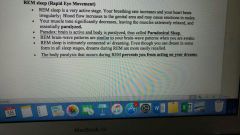
2 |
|
|
REM behavior disorder |
Condition in which normal muscle paralysis does not occur, leading to violent movements during rem sleep Mainly affects older men |
|
|
Narcolepsy |
Rare sleep.disorder in which a person falls asleep during alert activities in the day. |
|
|
Sleep apnea |
Sleep disorder in which person stops breathing during sleep. Suggested to be 1 cause of sudden infant death syndrome, or crib death. |
|
|
Restless leg syndrome |
Person has unpleasant sensations in the legs and an irresistible urge to move them to relieve the pain. |
|
|
Periodic limb movement |
Involuntary leg twitches or jerking movements during the sleep that occur roughly every 15-40 seconds, sometimes throughout the night. |
|
|
Nightmares vs night terrors |
NMs: rem sleep, vividly recalled NTs: nonrem sleep, not remembered, heart rate and breathing are rapid. |
|
|
Enuresis |
Person over age of 5 shows an inability to control urination during sleep. |
|
|
For each hour of time change it takes . . . |
1 day to reset our sleep circadian rhythm |
|
|
Continuity hypothesis |
Dreaming is a way of coping with daily problems and issues |
|
|
Memory theory |
Dreams are a way to consolidate info and get rid of trivial details in our memories |
|
|
Problem solving view |
We dream and we get answers |
|
|
Threat stimulation theory |
Dreaming allows us to stimulate potentially threatening situations so that we can rehearse our responses to these events. |
|
|
Activation-synthesis theory |
Suggests that dreams are the product of random firing of neural impulses during rem sleep |
|
|
Depressants |
Drugs that inhibit or slow down normal neural fxningAlcohol, barbiturates, and sedatives fxning Alcohol, barbiturates, and sedatives |
|
|
Alcohol |
Affects GABA, Binge drinking: excessive alcohol use over a short period of time that brings a person's BAC to 0.08% or above. |
|
|
Rohypnol "roofies" |
Date rape drug, tranquilizer, combined effects of alcohol and rohypnol renders her unconscious and she may not recall the event. |
|
|
Opiates (narcotics) |
Painkilling drugs that depress some areas of the brain and excite others Help with pain relief, can be great for surgery, but can be very addictive They mimick pain inhibiting NTs in The body such as endorphins. Morphein, codeine, heroin, opium In addition to blocking pain, they produce an intense rush of pleasure that is like floating on a cloud. |
|
|
Stimulants |
Drugs that speed up normal brain fxning, increase alertness and mobility, decrease rxn time Caffeine, nicotine, cocaine and crack, amphetamines, MDMA (ecstasy) |
|
|
Hallucinogens |
Simultaneously excite and inhibit normal neural activity, thereby causing distortions in perceptions, produce hallucinations or false perceptions. Marijuana, synthetic marijuana(k2 and spice), phencyclidine (PCP), LSD(acid) |
|
|
James Lange theory |
Theory of emotion that defines an emotion as a unique pattern of physiological arousal |
|
|
Cannon-bard theory |
Theory of emotion that states emotions originate in the brain, not the body |
|
|
Two factor theory of emotion |
States that emotions result when we cognitively interpret our phsyiological reactions in light of the situation, emotions are a product of both phsyiological arousal and cognitive interpretations of this arousal |
|
|
Cognitive mediational theory |
Theory of emotion that states that our cognitive appraisal of a situation determines what emotion we feel in the situation |
|
|
Modeling is a 4 step process |
Attention, retention in memory, reproduction of the behavior, motivation |
|
|
Habituation |
Tendency of an organism to ignore repeated stimuli Simplest type of learning seen in living things. |
|
|
Encoding |
The act of inputting info into memory |
|
|
3 stages model of memory |
Sensory memory, STM, LTM, Problem: proposes that we can only reach LTM through STM, which isn't always true (Reading a book, using LTM of reading before STM of trying to remember info) serial |
|
|
Working memory model, parallel memory |
Component of LTM that contains STM, central executive(attention controlling component), phonological loop (processes auditory info), and visuospatial sketchpad(processes visual and spatial info), we process diff aspects of memory at the same time |
|
|
Divergent thinking |
Ability to generate many ideas quickly in response to a single prompt |
|
|
Insight |
New way of looking at a problem that leads to a sudden understanding of how to solve a problem, aha moment |
|
|
Incubation |
Period of not thinking about a problem that helps one solve the problem. |
|
|
Intelligence quotient |
(MA/CA)*100 (MCAT) |
|
|
Preconscious |
Holds thoughts, perceptions, and impulses of which we could potentially be aware. |
|
|
Id, ego, superego |
Id: unconscious part that seeks pleasure, pleasure principle Ego: conscious part that attempts to meet demands of id in a socially appropriate way(reality principle) Superego: moral conscious. |
|
|
Psychosexual stages |

1 |
|
|
Piaget's stages of cognitive development |
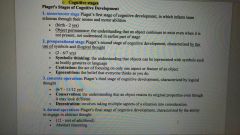
1 |
|
|
Erikson's psychosocial stages |
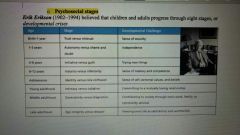
1 |
|
|
Attachment |
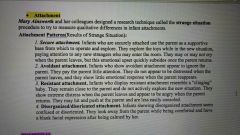
1 |
|
|
Primary and secondary appraisal |
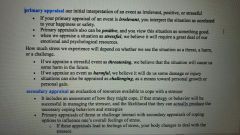
1 |
|
|
Stages of stress/ the general adaptation syndrome (GAS) |
Alarm reaction: immediate activation of the NS and endocrine system Resistance stage: NS and endocrine system continue to be activated, body's resources begin to dwindle Exhaustion stage: bodily resources are drained and wear and tear on body begins |
|
|
Cognitive distortion |
Thought that tends to be pessimistic and negative, distorted thinking patterns such as overgeneralization or all or none thinking that can lead to depression, anxiety or low self esteem. |
|
|
Major types of disorders |
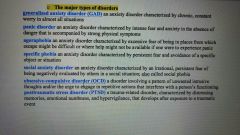
1 |
|
|
Major types of disorders |
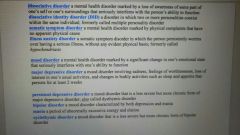
2 |
|
|
Major types of disorders |
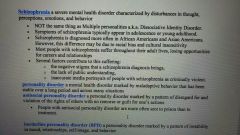
3 |
|
|
Delusion vs hallucinations |
Delusion; thought or belief that a person believes to be true but isn't Hallucinations; perceiving something that doesn't exist in reality |
|
|
Catonic stupor |
Positive symptom of schizophrenia marked by disorder in motor behavior involving immobility. |
|
|
Pyschoanalytic therapies |
Free association, Dream analysis, interpretation(psychoanalysts view on the themes and issues that may be influencing the clients behavior), Transference(client unconsciously reacts to the therapist as if he were a friend, family member, or partner), psychodynamic therapy(modern psychoanalysis delivered in a shorter time focusing on the clients current problems rather than on his past) |
|
|
Humanistic therapy |
Client centered therapy(empathy, genuineness, and unconditional positive regard) |
|
|
Behavior therapy |
CC techniques: systematic desensitization (replaces anxiety or fear with response of relaxation and positive emotion), flooding(client is exposed to a feared object for a long time), aversion therapy(specific behavior is paired with an unpleasant stimulus in order to reduce its occurrence), covert sensitization (milder form of aversion Therapy, graphic imagery is used) OC techniques: Positive reinforcement, nonreinforcemnt and extinction, punishment, shaping(positively reinforcing each successive attempt at a behavior followed by a negative consequence), token economy. |
|
|
Cognitive therapies |
Rational emotive therapy: focuses on changing the irrational beliefs that impede mental health Cognitive therapy: focuses on uncovering negative automatic patterns that impede mental health. |
|
|
Biomedical therapies |
Psychopharmacology: use of meds to treat mental health problems Antidepressants: meds prescribed to alleviate the symptoms of depression, eating disorders and some anxiety disorders Antimanic meds: drugs that alleviate manic symptoms of bipolar disorder Transcranial magnetic stimulation: electromagnetic impulses stimulate brain neurons, used to treat depression Electroconvulsive therapy: electrical current is passed through brain, causing a seizure, used to alleviate depression, last resort treatment option Psychosurgery: neurosurgery to alleviate symptoms in someone with a mental health disorder |

